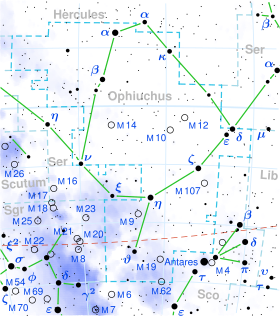58 Ophiuchi
Appearance
| Observation data Epoch J2000 Equinox J2000 | |
|---|---|
| Constellation | Ophiuchus |
| Right ascension | 17h 43m 25.79370s[1] |
| Declination | −21° 40′ 59.4980″[1] |
| Apparent magnitude (V) | 4.86[2] |
| Characteristics | |
| Spectral type | F5V[3] |
| U−B color index | -0.03[4] |
| B−V color index | +0.47[4] |
| Astrometry | |
| Radial velocity (Rv) | +10.20[5] km/s |
| Proper motion (μ) | RA: -97.54[1] mas/yr Dec.: -44.56[1] mas/yr |
| Parallax (π) | 56.65 ± 0.24 mas[1] |
| Distance | 57.6 ± 0.2 ly (17.65 ± 0.07 pc) |
| Absolute magnitude (MV) | 3.63[2] |
| Details[6] | |
| Mass | 1.20 M☉ |
| Radius | 1.43±0.05 R☉ |
| Luminosity | 3.02[2] L☉ |
| Surface gravity (log g) | 4.21±0.10 cgs |
| Temperature | 6,305±80 K |
| Metallicity [Fe/H] | −0.16±0.06 dex |
| Rotational velocity (v sin i) | 12.2±0.7 km/s |
| Age | 2.652[7] Gyr |
| Other designations | |
| Database references | |
| SIMBAD | data |
58 Ophiuchi is a single[9] star in the equatorial constellation of Ophiuchus. It is visible to the naked eye as a faint, yellow-white hued star with an apparent visual magnitude of 4.86.[2] This object is approximately 57.6 light years away based on parallax,[1] and is drifting further from the Earth with a heliocentric radial velocity of +10 km/s.[5]
This is an ordinary F-type main-sequence star with a stellar classification of F5V.[3] It is 2.7[7] billion years old with a projected rotational velocity of 12 km/s. The star has an estimated 1.2 times the mass of the Sun and 1.43 times the Sun's radius.[6] It is radiating three[2] times the luminosity of the Sun from its photosphere at an effective temperature of 6,305 K.[6]
References
[edit]- ^ a b c d e f Van Leeuwen, F. (2007). "Validation of the new Hipparcos reduction". Astronomy and Astrophysics. 474 (2): 653–664. arXiv:0708.1752. Bibcode:2007A&A...474..653V. doi:10.1051/0004-6361:20078357. S2CID 18759600. Vizier catalog entry
- ^ a b c d e Anderson, E.; Francis, Ch. (2012). "XHIP: An extended hipparcos compilation". Astronomy Letters. 38 (5): 331. arXiv:1108.4971. Bibcode:2012AstL...38..331A. doi:10.1134/S1063773712050015. S2CID 119257644. Vizier catalog entry
- ^ a b Gray, R. O.; Corbally, C. J.; Garrison, R. F.; McFadden, M. T.; Bubar, E. J.; McGahee, C. E.; O'Donoghue, A. A.; Knox, E. R. (2006). "Contributions to the Nearby Stars (NStars) Project: Spectroscopy of Stars Earlier than M0 within 40 pc--The Southern Sample". The Astronomical Journal. 132 (1): 161–170. arXiv:astro-ph/0603770. Bibcode:2006AJ....132..161G. doi:10.1086/504637. S2CID 119476992.
- ^ a b Mallama, A. (2014). "Sloan Magnitudes for the Brightest Stars". The Journal of the American Association of Variable Star Observers. 42 (2): 443. Bibcode:2014JAVSO..42..443M.Vizier catalog entry
- ^ a b Gontcharov, G. A. (2006). "Pulkovo Compilation of Radial Velocities for 35 495 Hipparcos stars in a common system". Astronomy Letters. 32 (11): 759–771. arXiv:1606.08053. Bibcode:2006AstL...32..759G. doi:10.1134/S1063773706110065. S2CID 119231169.
- ^ a b c Fuhrmann, K.; Chini, R. (2015). "Multiplicity Among F-Type Stars. II". The Astrophysical Journal. 809 (1): 107. Bibcode:2015ApJ...809..107F. doi:10.1088/0004-637X/809/1/107. S2CID 126218052.
- ^ a b David, Trevor J.; Hillenbrand, Lynne A. (2015). "The Ages of Early-Type Stars: Strömgren Photometric Methods Calibrated, Validated, Tested, and Applied to Hosts and Prospective Hosts of Directly Imaged Exoplanets". The Astrophysical Journal. 804 (2): 146. arXiv:1501.03154. Bibcode:2015ApJ...804..146D. doi:10.1088/0004-637X/804/2/146. S2CID 33401607. Vizier catalog entry
- ^ "58 Oph". SIMBAD. Centre de données astronomiques de Strasbourg. Retrieved 2019-06-21.
- ^ Eggleton, P. P.; Tokovinin, A. A. (September 2008), "A catalogue of multiplicity among bright stellar systems", Monthly Notices of the Royal Astronomical Society, 389 (2): 869–879, arXiv:0806.2878, Bibcode:2008MNRAS.389..869E, doi:10.1111/j.1365-2966.2008.13596.x, S2CID 14878976.


